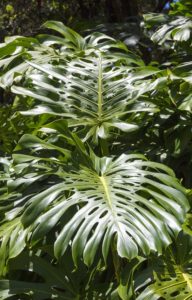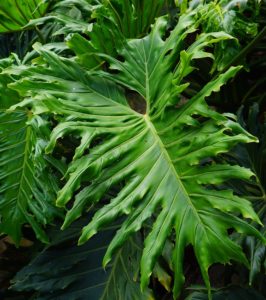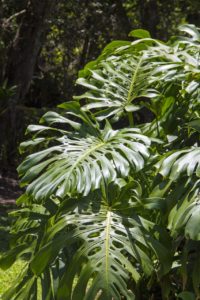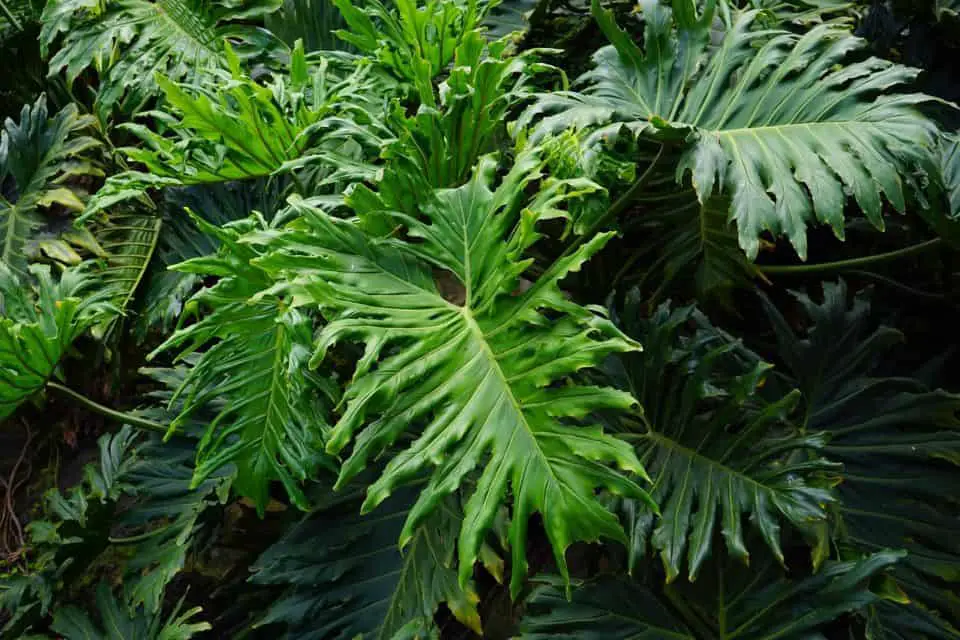Some links in the post are affiliate links and I get a commission from purchases made through some links found in the post.
If you enjoy outdoor gardens then it is very likely that you have seen beautiful Philodendrons in landscaping. They are very popular and well used in both indoor and outdoor settings.
Philodendron Selloum is a fairly large plant and used to be the most commonly grown and used of the species until recently when the Philodendron Xanadu first appeared.
The Philodendron Xanadu used to be called the Winterbourn – after the growers, Veronica and Barry Winterbourn.
What is interesting is that the original patent says that the plant was grown from a seed which came from a collection of Selloum seeds, and they all originated in Australia.
There are some differences between the two so let’s look at the Philodendron Selloum vs Xanadu.
The main differences between the Philodendron Xanadu and the Selloum is the foliage size and the height the plants get to. Philodendron Selloum will reach up to 6 feet high and up to 5 feet wide whilst the Philodendron Xanadu will only grow up to 3 feet tall and 5 feet wide.
Philodendron Selloum vs Xanadu – How to Identify the Differences
 Normally with any similar plants the main difference will be found in the leaves, and the Philodendron is no different here.
Normally with any similar plants the main difference will be found in the leaves, and the Philodendron is no different here.
The Xanadu has a firm feel to its leaves and you will also notice a red mid rib. This will be more prominent in lighter conditions.
The leaves are considerably smaller than those of the Selloum. Selloum leaves will become huge as the tree matures.
You will find that the Xanadu is quite a large plant which is easy to grow. Each of the leaves has 15 – 20 clear lobes.
This species is most likely going to be wider than taller and will reach maturity at about 2-4’ high and 3-5’ wide.
The Selloum is also grown for the magnificent foliage but you will see that these leaves can grow to around 1.5 metres in length!
The Selloum has a smaller base than the Xanadu and the leaves grow outward from the base. As the plant matures the base develops almost like a trunk.
Philodendron Selloum vs Xanadu – How to Care for Them
Generally, the Philodendron is a fast growing and easy to maintain plant.
They tend to be forgiving and tolerate poor lighting conditions and inconsistent watering routines.
They even do well in poor soil, so it is easy to see why they are popular with gardeners of all levels of enthusiasm.
Light
Selloums need bright, indirect light to do well. Ideally they need to be placed close to an east or south facing window to be at their best.
They will also grow in lower light, but you will find that the leaves become a darker shade of green. Keep them out of direct sun as this can burn the leaves.
Xanadus need more light than the other philodendrons if they are to keep their compact looks. They will do well in medium indirect light.
If you have placed your Xanadu in very bright light you will see that the leaves turn pale and look bleached.
Additionally, if they receive too little light the stems will become leggy as they go in search of it. Keep them out of direct sun as it will burn the leaves.
If your plants are struggling due to light, trying using this to help regulate the lighting.
Water
With the Selloum you should water when the soil is dry to a depth of just 1 – 2”. Give it a good water until the water runs over the top and then pour excess water away.
These plants do not appreciate having their feet kept wet because this will cause root rot. During the winter months the soil should be barely moist.
Your Xanadu plant will need to be watered until it comes out the bottom drip holes. You should also let the top half of the soil dry out before watering again.
If the soil stays wet for a long period the leaves will start to turn yellow. Because Xanadus grow slower in the winter, they will need less water at that time.
If you need help watering your plants, try using this automatic drip irrigation kit.
Humidity
Although the Xanadu will do well in a house with ‘regular’ humidity, they prefer high humidity.
Selloums on the other hand, need far higher humidity to thrive. It is important that their leaves are misted often in the drier months.
Temperatures
Your Selloum will be at its best at temperatures of above 55°F. It is important that they are kept away from drafts from open doors and windows, especially in the winter months.
Daytime temperatures of between 75° to 80°F, with night-time temperatures of between 65°- 70° F will ensure that your Xanadu is happiest.
Fertilizer
The Selloum needs to be fed during spring and the summer and they prefer the fertilizer to be diluted to half strength.
Excess food will cause a build-up of salt in the soil and you will find the plant shows leaf burn.
You need to feed your Xanadu during spring and fall, every second week. They do not need any during the winter months.
A clue as to if the plant needs extra food is if you notice the leaves are smaller and new growth seems slow.
Try this easy to use fertilizer to give your plants that little boost.
Pests and Diseases
 The main problems with the Xanadu are aphids and mealy bugs, both of which love the plant. You may also see spider mites if the air is dry.
The main problems with the Xanadu are aphids and mealy bugs, both of which love the plant. You may also see spider mites if the air is dry.
These are also a problem with the Selloum plant and can be fixed by regularly spraying the plants with warm soapy water.
Leaf spot disease is common in Xanadu plants, and root rot can damage the plant if not rectified.
Selloums suffer from bacterial blight which manifests itself in small dark green blotches on the leaves.
You should make sure that the leaves are dry at all times and remove leaves which are infected right away.
Pot Size
Both plants need to be re-potted when the roots have filled their pots.
The next size in pot should be no more than 2” more across than the old pot and should have drainage holes at the base.
Soil Choices
The Xanadu will thrive in soil which is high in organic matter and drains well while the Selloum needs rich, slightly alkaline soil which retains moisture.
Toxicity
Both the Philodendron Xanadu and the Selloum are toxic to humans and to animals.
If ingested there will be swelling of the tongue and lips, irritation to the stomach and vomiting.
If you are enjoying this article, check out our article on how to care for a philodendron over winter.
Philodendron Selloum vs Xanadu – How Much do They Cost?
A good-sized Philodendron Selloum will set you back about $30 while a similar sized Xanadu will cost around $25.
Philodendron Selloum vs Xanadu – Do They Need Full Sun?
The Selloum enjoys medium or bright indirect light. It will not do well if it is in the shade or a low light area.
While it may tolerate bright light, it will not thrive there. It also needs to be placed in a humid area or kept humid artificially.
Your Xanadu plant will do well in anything from full shade to full sunlight.
It is not fussy about where you place it in the house, and you will find that in full sun areas the leaves will be more deeply lobed.
Philodendron Selloum vs Xanadu – Can They be Grown Indoors?
Both the Philodendron Selloum and the Xanadu can be planted indoors.
This works very well with the Xanadu if you live in an area where you get heavy frost. They do not do well in frost or very cold climates.
As long as you can keep the area around your Selloum humid and moist this plant will also thrive indoors.
Watering Philodendrons
As with many indoor plants the correct watering technique is important if you want your plant to do well.
Of the two watering issues, namely over and underwatering, overwatering is the worst.
Too much water can often be the cause of a fungal disease which may ultimately kill your plant, while underwatering will only dehydrate the plant.
It is possible to survive underwatering and save the plant.
Another tip is to never let either your Selloum or Xanadu sit in water. This is something that they do not like, and they will end up with damaged roots.
Final Thoughts
 In the debate about Philodendron Selloum vs Xanadu there are good points for both plants. Both cost about the same and both are relatively easy to maintain.
In the debate about Philodendron Selloum vs Xanadu there are good points for both plants. Both cost about the same and both are relatively easy to maintain.
They do not have many pest and disease issues, and most can be addressed by adjusting water routines or washing with warm soapy water.
Both plants will be large when they are fully grown although the Selloum will be bigger than the Xanadu.
While their needs are slightly different, particularly for using as indoor plants, it is easy to keep them happy with a little forethought on best placement and lighting conditions.
Possibly the most important thing to remember is that both the Selloum and the Xanadu are toxic to pets, children, and adults.
They will cause great discomfort, stomach issues and vomiting, and can be fatal to small children and animals.
If you plan on getting a pet or having a baby, then this may not be the best indoor plant for you.
Having said that, these are magnificent plants which when they do well are simply spectacular and a joy in any home or garden.
Before you go, here are some more related articles I encourage you to read below to help solve more of your gardening issues:
How to fix your philodendron selloum problems
Can a Philodendron be put Outside
What are the Benefits of Having a Philodendron
Can Philodendron Grow in Shade
How to Care for a Philodendron Tiger Tooth
What is the Rarest Philodendron
Why is my Philodendron Brasil Dying
How to Propagate Philodendrons in Water
Why is My Philodendron Turning Red
Written by: Valerie Holyoak


